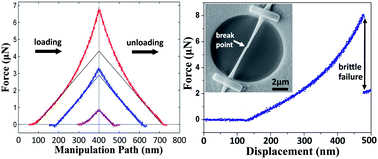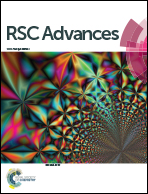Mechanical bending properties of sodium titanate (Na2Ti3O7) nanowires†
Abstract
We report on the mechanical properties of sodium titanate nanowires (Na2Ti3O7 NW) through a combination of bending experiments and theoretical analysis. Na2Ti3O7 NWs with lateral dimensions ranging from 20–700 nm were synthesized by a hydrothermal approach. A focused ion beam (FIB) was used to manipulate the selected Na2Ti3O7 NW over a hole drilled in an indium tin oxide substrate. After welding the nanowire, a series of bending tests was performed. It was observed that the Na2Ti3O7 NW exhibits a brittle behavior, and a nonlinear elastic deformation was observed before failure. By using the modified Euler–Bernoulli beam theory, such nonlinear elastic deformation is found to originate from a combination of surface effects and axial elongation (arising from the bending deformation). The effective Young's modulus of the Na2Ti3O7 NW was found to be independent of the wire length, and ranges from 21.4 GPa to 45.5 GPa, with an average value of 33 ± 7 GPa. The yield strength of the Na2Ti3O7 NW is measured at 2.7 ± 0.7 GPa.


 Please wait while we load your content...
Please wait while we load your content...